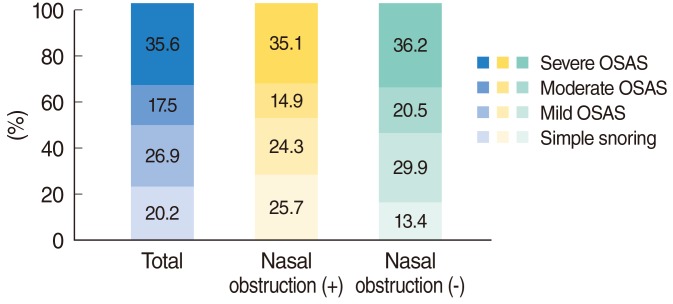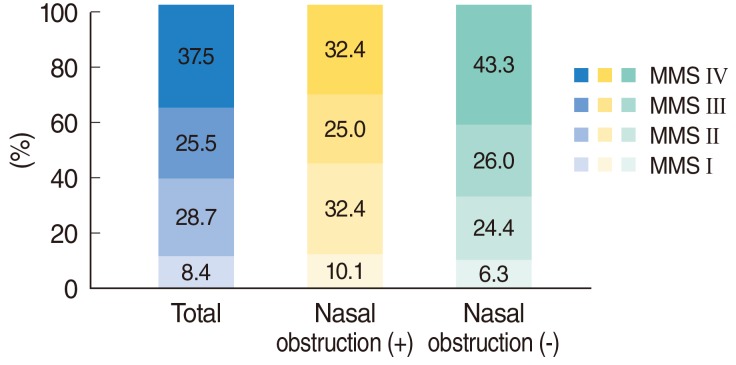Clin Exp Otorhinolaryngol.
2013 Dec;6(4):226-230.
Nasal Obstruction and Palate-Tongue Position on Sleep-Disordered Breathing
- Affiliations
-
- 1Department of Otorhinolaryngology-Head and Neck Surgery, Samsung Medical Center, Sungkyunkwan University School of Medicine, Seoul, Korea. hjdhong@skku.edu
Abstract
OBJECTIVES
We wanted to evaluate whether the presence of nasal obstruction makes a change on the association between the modified Mallampati score and the severity of sleep-disordered breathing (SDB) and the sleep quality.
METHODS
Polysomnography (PSG), the modified Mallampati score (MMS), the body-mass index, and a questionnaire about nasal obstruction were acquired from 275 suspected SDB patients. The subjects were divided into two groups according to the presence of nasal obstruction. The clinical differences between the two groups were evaluated and the associations between the MMS and PSG variables in each group were also assessed.
RESULTS
Significant correlations were found between the MMS and many PSG variables, including the apnea-hypopnea index, the arousal index and the proportion of deep sleep, for the patients with nasal obstruction, although this was not valid for the total patients or the patients without nasal obstruction.
CONCLUSION
The severity of SDB and the quality of sleep are well correlated with the MMS, and especially for the patients with nasal obstruction. The MMS can give more valuable information about the severity of SDB when combined with simple questions about nasal obstruction.
Keyword
MeSH Terms
Figure
Reference
-
1. Kim HY, Bok KH, Dhong HJ, Chung SK. The correlation between pharyngeal narrowing and the severity of sleep-disordered breathing. Otolaryngol Head Neck Surg. 2008; 3. 138(3):289–293. PMID: 18312873.
Article2. Lee SH, Choi JH, Shin C, Lee HM, Kwon SY, Lee SH. How does open-mouth breathing influence upper airway anatomy? Laryngoscope. 2007; 6. 117(6):1102–1106. PMID: 17464234.
Article3. Friedman M, Tanyeri H, La Rosa M, Landsberg R, Vaidyanathan K, Pieri S, et al. Clinical predictors of obstructive sleep apnea. Laryngoscope. 1999; 12. 109(12):1901–1907. PMID: 10591345.
Article4. Friedman M, Ibrahim H, Joseph NJ. Staging of obstructive sleep apnea/hypopnea syndrome: a guide to appropriate treatment. Laryngoscope. 2004; 3. 114(3):454–459. PMID: 15091218.
Article5. Kim HY, Min JY, Cho DY, Chung SK, Dhong HJ. Influence of upper airway narrowing on the effective continuous positive airway pressure level. Laryngoscope. 2007; 1. 117(1):82–85. PMID: 17202935.
Article6. EEG arousals: scoring rules and examples: a preliminary report from the Sleep Disorders Atlas Task Force of the American Sleep Disorders Association. Sleep. 1992; 4. 15(2):173–184. PMID: 11032543.7. Ferris BG Jr, Mead J, Opie LH. Partitioning of respiratory flow resistance in man. J Appl Physiol. 1964; 7. 19:653–658. PMID: 14195575.
Article8. Armengot M, Hernández R, Miguel P, Navarro R, Basterra J. Effect of total nasal obstruction on nocturnal oxygen saturation. Am J Rhinol. 2008; May-Jun. 22(3):325–328. PMID: 18588768.
Article9. Miljeteig H, Hoffstein V, Cole P. The effect of unilateral and bilateral nasal obstruction on snoring and sleep apnea. Laryngoscope. 1992; 10. 102(10):1150–1152. PMID: 1405965.
Article10. Miljeteig H, Savard P, Mateika S, Cole P, Haight JS, Hoffstein V. Snoring and nasal resistance during sleep. Laryngoscope. 1993; 8. 103(8):918–923. PMID: 8361295.
Article11. De Vito A, Berrettini S, Carabelli A, Sellari-Franceschini S, Bonanni E, Gori S, et al. The importance of nasal resistance in obstructive sleep apnea syndrome: a study with positional rhinomanometry. Sleep Breath. 2001; 1. 5(1):3–11. PMID: 11868135.
Article12. Lofaso F, Coste A, d'Ortho MP, Zerah-Lancner F, Delclaux C, Goldenberg F, et al. Nasal obstruction as a risk factor for sleep apnoea syndrome. Eur Respir J. 2000; 10. 16(4):639–643. PMID: 11106205.
Article13. Craig TJ, Mende C, Hughes K, Kakumanu S, Lehman EB, Chinchilli V. The effect of topical nasal fluticasone on objective sleep testing and the symptoms of rhinitis, sleep, and daytime somnolence in perennial allergic rhinitis. Allergy Asthma Proc. 2003; Jan-Feb. 24(1):53–58. PMID: 12635578.14. Craig TJ, Teets S, Lehman EB, Chinchilli VM, Zwillich C. Nasal congestion secondary to allergic rhinitis as a cause of sleep disturbance and daytime fatigue and the response to topical nasal corticosteroids. J Allergy Clin Immunol. 1998; 5. 101(5):633–637. PMID: 9600500.15. Hughes K, Glass C, Ripchinski M, Gurevich F, Weaver TE, Lehman E, et al. Efficacy of the topical nasal steroid budesonide on improving sleep and daytime somnolence in patients with perennial allergic rhinitis. Allergy. 2003; 5. 58(5):380–385. PMID: 12797340.
Article16. Kiely JL, Nolan P, McNicholas WT. Intranasal corticosteroid therapy for obstructive sleep apnoea in patients with co-existing rhinitis. Thorax. 2004; 1. 59(1):50–55. PMID: 14694248.17. Rombaux P, Liistro G, Hamoir M, Bertrand B, Aubert G, Verses T, et al. Nasal obstruction and its impact on sleep-related breathing disorders. Rhinology. 2005; 12. 43(4):242–250. PMID: 16405266.18. Vural C, Gungor A. The effect of topical fluticasone on nasal nitric oxide levels in a patient with allergic rhinitis. Ear Nose Throat J. 2003; 8. 82(8):592–597. PMID: 14503095.
Article19. Series F, St Pierre S, Carrier G. Surgical correction of nasal obstruction in the treatment of mild sleep apnoea: importance of cephalometry in predicting outcome. Thorax. 1993; 4. 48(4):360–363. PMID: 8511733.
Article20. Fitzpatrick MF, McLean H, Urton AM, Tan A, O'Donnell D, Driver HS. Effect of nasal or oral breathing route on upper airway resistance during sleep. Eur Respir J. 2003; 11. 22(5):827–832. PMID: 14621092.
Article21. Koutsourelakis I, Georgoulopoulos G, Perraki E, Vagiakis E, Roussos C, Zakynthinos SG. Randomised trial of nasal surgery for fixed nasal obstruction in obstructive sleep apnoea. Eur Respir J. 2008; 1. 31(1):110–117. PMID: 17898015.
Article22. McLean HA, Urton AM, Driver HS, Tan AK, Day AG, Munt PW, et al. Effect of treating severe nasal obstruction on the severity of obstructive sleep apnoea. Eur Respir J. 2005; 3. 25(3):521–527. PMID: 15738298.
Article23. Park SS. Flow-regulatory function of upper airway in health and disease: a unified pathogenetic view of sleep-disordered breathing. Lung. 1993; 11. 171(6):311–333. PMID: 8295427.
Article24. Georgalas C. The role of the nose in snoring and obstructive sleep apnoea: an update. Eur Arch Otorhinolaryngol. 2011; 9. 268(9):1365–1373. PMID: 21340561.
Article25. Mirza N, Lanza DC. The nasal airway and obstructed breathing during sleep. Otolaryngol Clin North Am. 1999; 4. 32(2):243–262. PMID: 10385535.
Article26. Andre RF, Vuyk HD, Ahmed A, Graamans K, Nolst Trenite GJ. Correlation between subjective and objective evaluation of the nasal airway: a systematic review of the highest level of evidence. Clin Otolaryngol. 2009; 12. 34(6):518–525. PMID: 20070760.27. Kim CS, Moon BK, Jung DH, Min YG. Correlation between nasal obstruction symptoms and objective parameters of acoustic rhinometry and rhinomanometry. Auris Nasus Larynx. 1998; 1. 25(1):45–48. PMID: 9512794.
Article28. McNicholas WT. The nose and OSA: variable nasal obstruction may be more important in pathophysiology than fixed obstruction. Eur Respir J. 2008; 7. 32(1):3–8. PMID: 18591332.
Article29. McNicholas WT, Tarlo S, Cole P, Zamel N, Rutherford R, Griffin D, et al. Obstructive apneas during sleep in patients with seasonal allergic rhinitis. Am Rev Respir Dis. 1982; 10. 126(4):625–628. PMID: 7125355.



